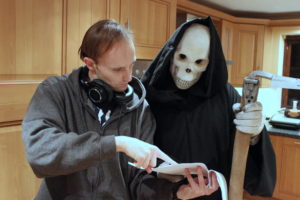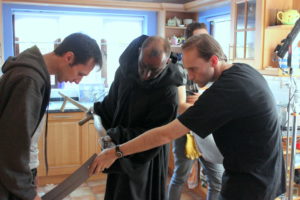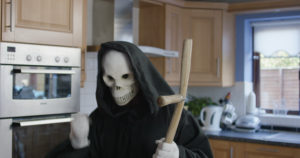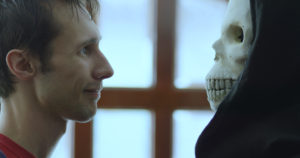Thunder…
It’s been a while since my last update. The projects themselves have taken precedence over blogging about them. And rather than repeat the blow-by-blow account of how to make a short film like I did for Brian & Grim, I thought I’d wait till it was time to tackle the big one. That time has almost come. But first, final notes on Thunder!
‘Thunder’ Under Control was a special project to me. It had the biggest crew of all my short films (to this day, in fact) and I was delighted to receive the support I did for it. Henriette Mercedes Spiering (Producer) & John Suriano (Associate Producer) deserve the most credit.
Thunder itself ended up being accepted at 2 film fests. Good, though not what I’d hoped for. So to present the best possible version of the film to audiences on-line I went back to the project to do a “director’s cut”. I won’t pretend my short’s perfect, though I do believe this new cut to be an improvement.
So why a director’s cut? The simple answer is that if you can find a way to make your film better, then you should. It cost me no money, though it did take up two months of my time. It’s punchier (sorry), better paced, and – I hope – more moving as a result. I’m not sure how many tweaks I did in total, but in one 3 minute segment I made 56 alterations. Some of these consisted of just a frame or two cut here and there. Others were more extensive.
This brings to an end a project that started late April 2015. At that point my shorts had received no film festival acceptances. I’ve now had 17. My most recent project, Boxes, has been accepted at 4 film fests and has won Best Short at two of them. I feel good things lie ahead.
I’ll chat more about my other projects in my next newsletter. They’ll start to become a bit more frequent now. This newsletter will also mark the start of the great campaign. The big push. The road to my most ambitious short film yet. This is, as they say, the big one…
The Making of Brian & the Grim Reaper
Though aimed at budding filmmakers, I hope this blog will be an entertaining read for everyone!
Inspiration, Then Perspiration – Pre-production
Trudging across a Hampshire field, in full retreat from the merciless weather, I wonder if I’ve gone too far. It’s halfway through day one on a damp October day and we’ve shot just 45 seconds of a 10 minute film. And I’ve only scheduled two days for it…
It starts so well. In 2014 I vow to abandon my writer’s desk and make my own stuff. But with no industry contacts is it feasible to make professional shorts? Chris Jones’ Guerilla Filmmaker’s Masterclass provides the answer. The event coincides with my friend’s cancer treatment, and together they spur me on to do something worthy.
Two things drive me on: the desire to collaborate with other creative, and an even stronger desire to entertain people.
TIP 1: If you’re writing as well as directing, have someone else provide objective feedback on the script. This was my first, invaluable collaboration.

After honing the script I lay out my plan. I’ll shoot it on a DSLR. One location. No music, no VFX. Keep costs down, I tell myself. A humble internet release will follow.
Didn’t work out like that. We shot it on a Red Epic Dragon in 6K in numerous locations with VFX work, an original score, and a 4K DCP created for festival submission. It cost over twice as much, but was ten times more professional.
TIP 2: 6K won’t make your film 6 times better; doing at least 6 drafts of your script, will.
The concept, as expressed in a pitch, is vital when getting something made. Needing crew, I place it on the filmmaking website ShootingPeople.org and cross my fingers:
“When Brian discovers his days are numbered he attempts to live in denial. But he cannot run from his fate. Brian must learn to live with Death – literally – or forever live in fear of him. There’s just one problem: Grim’s the housemate from hell.”
It works. Over twenty applications for the Director of Photography position flood in. Nearly half have shot features; one of them worked on Skyfall. I’m overwhelmed.
TIP 3: Spoilt for choice? Go for the person who shows the most passion for your project. If they love your film, they’ll probably love you. (Well, you know what I mean.)

The internet has democratised filmmaking. Utilised correctly, great talent is literally at your fingertips. Casting Call Pro provides the talented and versatile Ian Pink (Brian) and Dean Kilbey (Grim). They join within hours of reading the script. Preparation is key when you don’t have much money. I save up, pick locations, assemble props, set schedules and draw up a shot list. I’m ready. Or so I think.
It’s only after I pick my crew that I realise I’ve overlooked something: none of my London-based crew have cars. And crew bring equipment. This means I’ve more vehicles to hire in addition to other travel costs.
TIP 4: If shooting away from major cities, be aware of a lack of rental companies.
I find no adequate rental houses for the hiring of lighting, grip etc. in the Dorset / Hampshire region. And the clock is ticking. All the gear must come from London. My gaffer’s a godsend and drives it down in a hire van. In return I promise him sushi.
TIP 5: Keep your crew happy any small way that you can. They’ll go the extra mile.
Even this leads to another problem; he’s under 25, so it’s more expensive to hire him a vehicle. I don’t grumble, but there are lots of small expenses on a shoot and they mount up. One company won’t hire to under 25s at all.
It’s my DoP who suggests we shoot in 4K. Indeed, he has the kit. (Crew often have their own gear, which they hire out to supplement their income.) It’s expensive yet audiences will appreciate the quality. And what if it’s my only shoot? I go for it!

Here There Be Dragons – The Costs of Shooting in 4K
Red Dragons are expensive, hungry things. They gobble up huge numbers of gigabytes and you’ll need copious hard drive space to satiate them. A weekend of footage totals 750GB. Shooting in 4K (soon to become commonplace) means the production value of a film increases accordingly. These cameras pick up everything. For example, the Grim Reaper’s latex mask won’t do, so I’ve a fibre glass one made that can withstand the Dragon’s severe 6K scrutiny.
Ah, yes. About that 4K/6K thing. My DoP’s website specified a different Red camera to the one he turns up with. In fact, I don’t actually realise we’re shooting in 6K until halfway through day one. I keep shtum about it for fear it might harm my authority.
TIP 6: If you’re going to be an ignoramus, keep it to yourself.
The hard drives it records to need emptying to a laptop frequently, a job usually done by a Digital Imaging Technician. We did it ourselves but it takes up time. Beware.
Also, to properly light an interior scene with a high resolution requirement means a sophisticated lighting setup. In other words, more expense. Post-production costs go up too. Your editor will need equally sophisticated software to deal with the footage. Ditto your colourist. Adobe CS6 couldn’t handle Red Dragon footage at first. Weeks of delays ensued.
Brian, the Grim Reaper & the Cops – Production
October arrives. I’ve everyone up before dawn on day one. Exteriors first. Bad weather’s forecast and I figure it’s best to be rained off the first day than the last. I obtain council permission for filming in two key locations and take out the required insurance. Come the shoot, however, and nearby cliff tops entice us. It’s not in the script, but what the hell. We nab cool shots of Brian as he tries to run away from Death!
TIP 7: Never pass up a sweeping vista.

Torrential rain defeats us on the first morning, so we start on the interiors. My DoP Ewan Mulligan asks if I want to shoot the film’s longest scene in chronological order. It’s my first shoot so I say I do. Plus visual gags are up first and they require many takes to get right.
TIP 8: Schedule time-consuming scenes first, so that if things overrun at least they’ll overrun up front. This’ll give you more time to decide what not to film later on.
Rigidly adhering to storyboards and shot lists slows us down and blocks spontaneity. Ewan and I are in total agreement regarding the look of the film, so we stick to the shot list for key shots, not every shot.
In the evening we strike out from home base to finish off shooting exteriors. With the scenes shot at different times of the day, it’ll take both a good colourist and a VFX artist to maintain continuity in the scenes. I hadn’t originally budgeted for the latter.
TIP 9: Shoot footage of clouds on the day – you can insert them digitally in post.
Thank God I’ve secured permission to shoot elsewhere. While we shoot on the street an old man in a dressing gown, presumably watching the Grim Reaper ashen-faced, calls the cops on us. With council permission secured, however, the Police are on our side. Just as well: if we’d been shut down and moved along we’d have run out of time to complete the film…

Soon it’s the end of day one and we’ve shot three pages. (The visual gags took even longer to film than I thought.) I bite the bullet and cut over a page from the script – gags and two transition shots. They’re not essential to the story so they’ve gotta go.
Before my sleepless night I record some Foley with my sound recordist. We do this in the actual rooms we’re filming in. This provides a useful library of sound effects.
One of the keys to creating a no-ego set is to keep things relaxed and allow people to do their jobs. They don’t need to be reminded there’s little time left, and they’ll be happier for it. Day two runs smooth as silk. Despite the time factor I let my actors play with their characters. A dull transition shot turns into one of the funniest scenes in the film thanks to some acting improv.
TIP 10: Always leave room for spontaneity, especially if it’s a comedy.
I found it so helpful to have friends I could count on for support. They pull you through the dark times and enrich the good ones. Like day two.
We finish the hitch-free second day just as the sun goes down, the latest we could possibly finish. I now know the relief Luke Skywalker felt when he destroyed the Death Star at the very last second. I thank my crew for a great job. I pay everyone within a week. They made it happen!

Reaping What You’ve Sowed – Post-production
All decisions, good or bad, come back to haunt you during post. At this stage, a film’s journey takes it upon a vast ocean of competing codecs and file formats, whose complex rip-tides try to pull you under. I’m no match for the convoluted Redcode or the hefty DPX sequence; I rely on my post-production team to get me through.
I still make mistakes. I hesitate in getting the actors back for ADR. Post-production is well-advanced by the time I make this choice, making it trickier to incorporate.
TIP 11: ADR should be among the first things you do in post-production.
My 18 year old editor Shiona Penrake (already an award-winning filmmaker) pares down the edit to less than 10 minutes. She injects pace and energy into the story, and also overrules my choices on occasion too. For the better.
TIP 12: A good editor should know when to tell the director he’s mistaken; a director should know when to listen to her.
Keep a copy of the footage to refer to: my colourist and my VFX artist both request timecodes on the footage to help them with gaps in the EDL, amongst other things.
In case you wondered (as I did) about what a VFX artist needs in order to work his magic on a movie, it’s either a DPX or TIFF sequence of the scenes he must work on.
TIP 13: A DCP really requires 5.1 sound – a stereo mix won’t do.

Here’s my ideal post-production workflow: Editing > ADR > VFX > Sound Design / Foley > Music > Sound Mixing > Colourist > DCP creation (finished film)
A couple of these can run concurrently, but this is generally the right order. So, how could I afford this film if it cost well over twice as much? Well, post-production drags on so long it allows you to stagger the costs.
TIP 14: Save up enough to get the film in the can (production), then save up again. You’re essentially paying for your film in instalments.
It’s January, halfway through post, when I receive word that my friend has died from lung cancer. I feel desperately sad. I’d loved to have shown him the finished short. Given its subject matter, would it have been awkward viewing? It’s tough to say. I dedicate the film to him.
Journey’s End
After 8 months of work the film is complete. With the test screening a success I start submitting my short to film festivals while a trailer is cut. I’m drained but I write another already. In fact, I’ve done 5 short films and got them into 10 film festivals at time of writing. Plus Brian & Grim got its very own local TV broadcast as well!
TIP 15: Those who say you should wait till you’re ready to make a film have invariably made it already. You’ll never find out if you remain at the dreaming stage!
Making a film is like giving birth; there’s pain and there’s joy. During its production I lost a friend but found a role. I’m now an independent filmmaker. With no experience and no training I produced a quality short for audiences to enjoy.
You can do it too.

Watch Brian & the Grim Reaper on Eben’s YouTube channel: https://www.youtube.com/channel/UCMHoFAIgl8wTtc8NNqCEqdA
Twitter: https://twitter.com/EbenSkilleter
Facebook: https://www.facebook.com/eben.skilleter
BLOG ON BLOG
First up, the two trailers for my short film ‘Brian & the Grim Reaper’ are here:
https://www.youtube.com/channel/UCMHoFAIgl8wTtc8NNqCEqdA
What to leave in, what to leave out? I guess that’s what it’s all about.
Sounds like a song lyric. In fact it’s the chief dilemma when writing anything. Shortly after I finished my short, independent filmmaking legend Chris Jones asked me to write a blog on making ‘Brian & the Grim Reaper’ (see link at bottom).
It’s a funny and poignant glimpse into my endeavour, and includes 15 incredibly useful filmmaking tips. This blog is now on his website, as he promised me it would be. It strikes, I hope, a good balance, in that it neither rambles nor cuts things too short.
It means more to me than simply writing a blog and sticking it on a website. You see, Chris Jones is the author of The Guerilla Filmmaker’s Handbook, a blow-by-blow guide on how to make your own movie. He was one of my inspirations for ‘Brian & the Grim Reaper’. He instilled in me the belief that I could get out there and do it.
The greatest desire always comes from within. Yet sometimes it takes a teacher to light the fuse. Chris was it for me. In turn, if I can pass on what I’ve learnt from my exploits, I will.
We all have something to say; we often have too much. I followed these simple guidelines: Break things down to manageable chunks. Sprinkle your text with visuals, like so…
Emphasise your key points. And explain how you went about doing things, not just the why. I wrote 6 drafts of my blog for Chris before I was satisfied.
In order to aid would-be filmmakers, I’ll be exploring more aspects of the production in subsequent blogs. In particular, how I achieved professional-looking results on a tiny budget: tracking shots, visual gags, and creating memorable images.
The feature-length blog on ‘Brian & the Grim Reaper’ is here:
http://www.chrisjonesblog.com/2015/06/guerilla-filmmaking-director.html
E.
————————————————————————–
MISSION ACCOMPLISHED
I did it. Shortly before this website’s creation, ‘Brian & the Grim Reaper’ was completed. Shot with a professional cast and crew, it was filmed on a RED Epic Dragon – at time of shooting arguably the world’s most sophisticated digital camera.
I did this with no industry contacts.
No track record.
No prior experience.
They said it couldn’t be done; I proved them wrong.
I so wanted it to be a professional enterprise. Not for me a short film about two blokes sitting in a lounge talking. “When I go to the cinema,” I believe filmmaker Lynne Ramsay once said, “I want to have a cinematic experience”. And so I set out to give the audience just that.
I was very nervous, and I was mentally drained by the end. But the support of friends pulled me through.
Making a film is like giving birth; pain for a short while followed by the most intense feelings of joy, satisfaction and achievement.
I want to do it again.
More than anything I want to improve as a filmmaker. Audiences deserve better; they always deserve better. Filmmakers require their time and very often their money – it is our responsibility to give them the best experience possible.
I aim to write in much more detail about how I made Brian & the Grim Reaper. Tips, advice, strategy. This I’ll do on my blog.
I also plan to write about the making of my more ambitious next short, provisionally entitled ‘Thunder’ Under Control. How I’ll do it, when I’ll do it, what I’ll have to do to do it! This I’ll communicate via my newsletter.
This film will not be easy to make. They never are. And as I’ll share my trials and tribulations with you, so I hope we can go on this journey together as I attempt to make the impossible. Again.
E.

